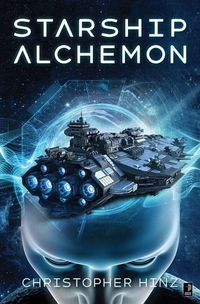
Published by Angry Robot on November 12, 2019
Starship Alchemon combines five science fiction elements: space opera, first contact, cyborgs, time travel, and humans with psionic abilities. The plot does nothing particularly new or special with any of those elements. An old sf adage suggests that writers should only ask readers to suspend their disbelief in a single thing. Five elements may be too many — no single theme in the hodgepodge is explored in depth — but Starship Alchemon achieves limited sucess as an action story.
The science team of the Alchemon finds a living organism on a dead planet. The organism has been encased in a rocky shell that has been eroding for centuries. A spherical blue life form emerges, nicknamed Bouncy Blue by one of the science team members. The sphere seems to contain a humanoid fetus. A psychic crew member named LeaMarsa is a bit unsettled by the discovery, but the crew nevertheless brings Bouncy Blue on board, storing it in a secure lab.
Captain Ericho Solorzano commands the Alchemon, but the ship is operated by a cyborg called Jonomy Jonomy. Lt. Tomer Donner is obsessed with a corporate bigwig named Renfro Zoobondi, whose various activities include a plan to thwart chronojackers, the “temporal pirates” who steal vessels and send them forward in time, where the pirates hope to find a better future.
Donner’s unstable reaction to Bouncy Blue sets up the novel’s second half. The alien entity become less bouncy and more threatening as it sheds its shield, giving birth to Baby Blue, a gravity-defying entity that, despite its confinement to the lab, battles Jonomy for control of the ship.
LeaMarsa has psionic blackouts, causing her to float around in “the alternative universe of neurospace.” They also seem to give her a particular insight into, and perhaps a connection with, Bouncy Blue. LeaMarsa is carried away by her personal drama, which may be having a psionic impact on the rest of the crew. By the end of the novel, she’s so wrapped up in self-pity that Solorzano is worried she might become allied with Baby Blue, despite being their only hope of surviving Baby Blue’s machinations.
Christopher Hinz tells the story in prose that sometimes seems hurried and unpolished. I don’t recall his earlier work being so stylistically lackluster. The novel is apparently a rewrite of his second novel, Anachronisms, which might explain the prose issues, although I would have expected a rewrite to eliminate clunkers from the prose.
Hinz philosophizes about the “evolutionary development of the physical, emotional and intellectual components of the brain,” which he ties to “the heartland of superluminal interaction,” but it all seems like window-dressing for what is essentially an action novel: crew members struggle to survive against the alien menace that wants to take over their ship. It’s been done before, countless times, and Hinz does nothing to transcend the stale plot.
On the other hand, the story moves quickly and has some interesting moments. One aspect of the ending is predictable but the story does culminate with at least one surprise. The universe building is a bit more interesting than the characters who inhabit the universe. Starship Alchemon will appeal to sf junkies who can’t get enough space opera, but there are certainly better choices in the marketplace.
RECOMMENDED WITH RESERVATIONS